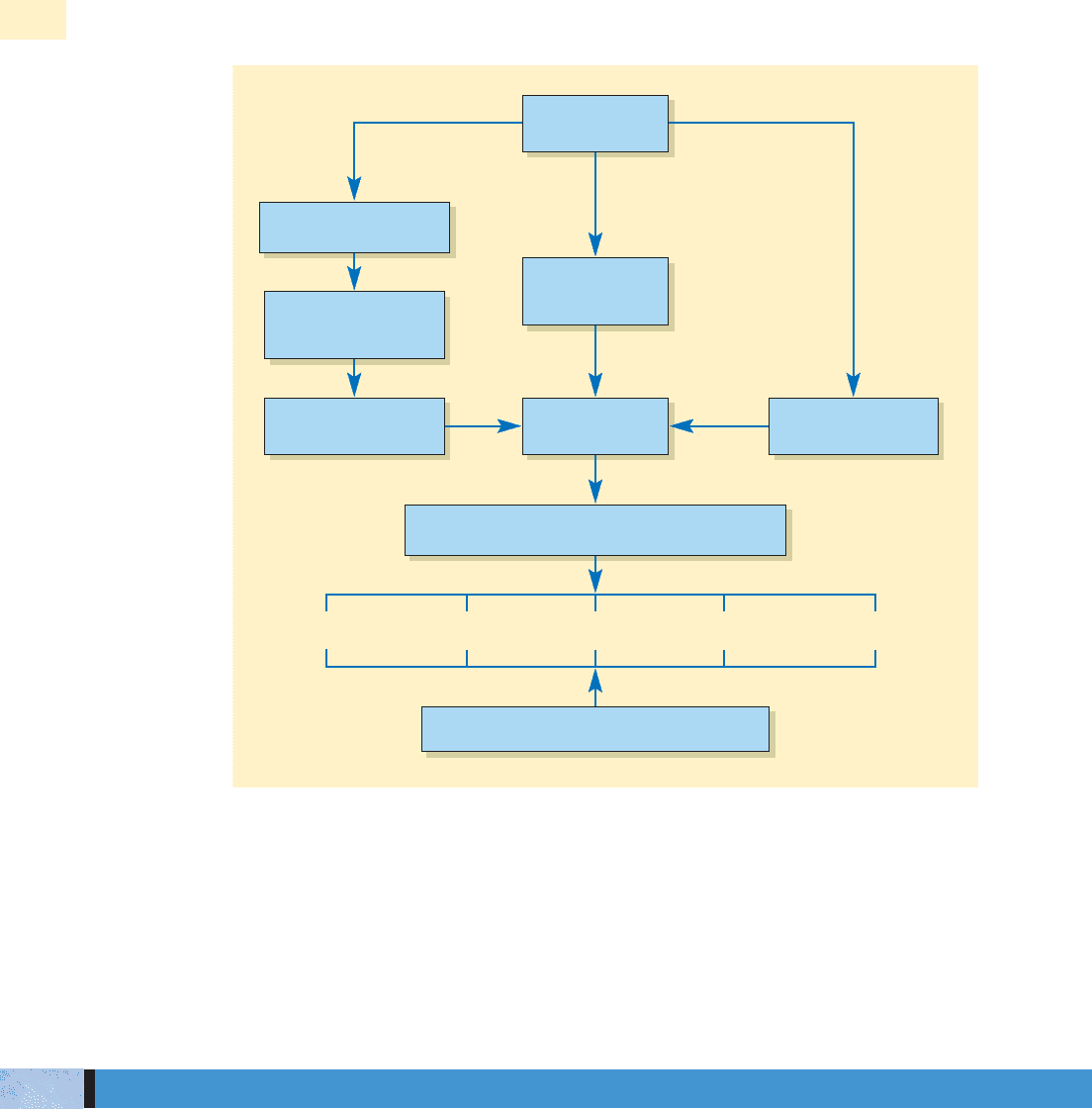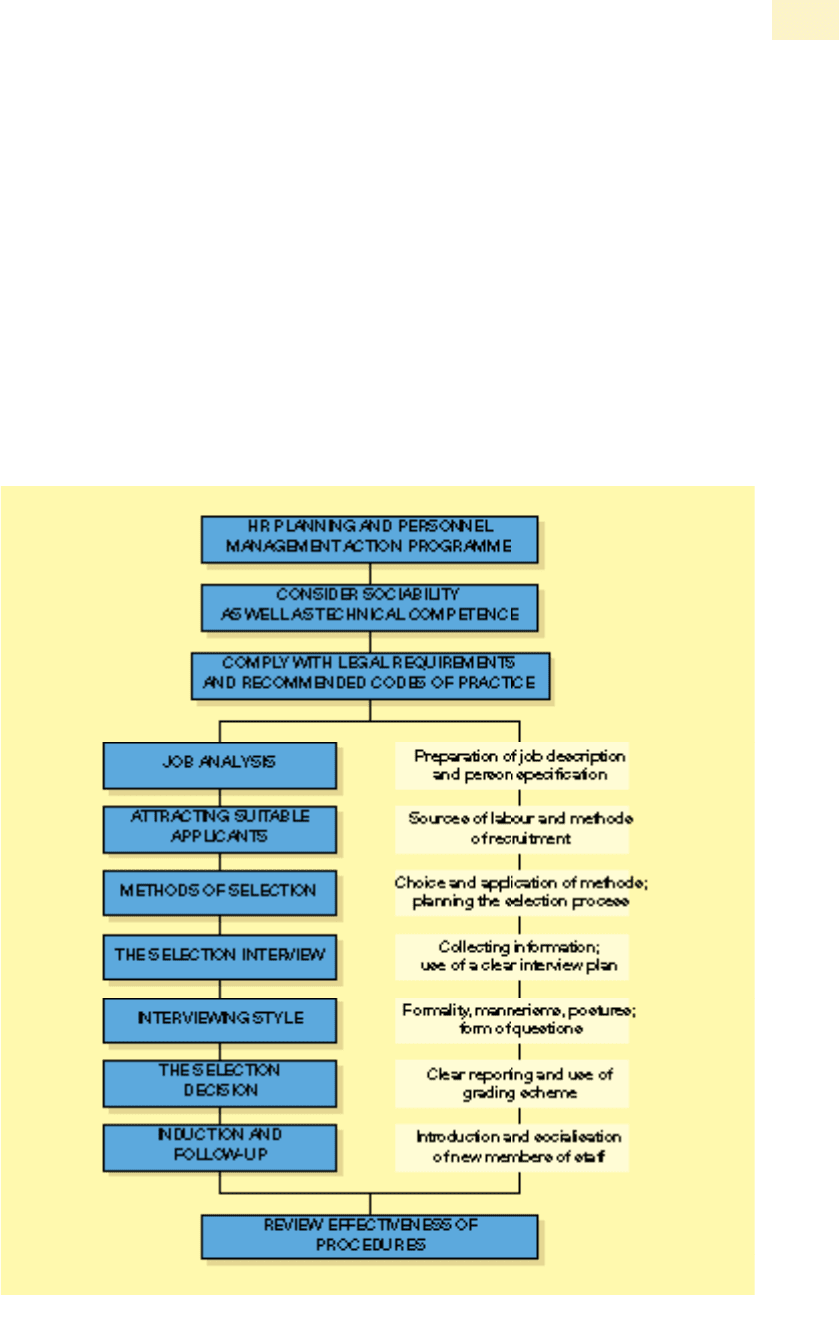Mullins L.J. Management and organisational behaviour, Seventh edition
Подождите немного. Документ загружается.


A lot of us, when evaluating job candidates, tend
to be so impressed by braininess, by what’s
inside a person’s head, that we seriously
undervalue the passion that person brings to an
enterprise.
Mark McCormack
McCormack on Managing, Century (1955)
The first part of choosing great people is to
analyse your own strengths and weaknesses.
That gives you an idea of where your needs are
greatest. The goal is to balance your weaknesses
with the strengths of others, then to evaluate the
team overall.
Rudolph Giuliani
Leadership, Time Warner (2002)
Whatever the nature of an organisation, the
effectiveness of its operations and functions
inevitably depends very largely upon the staff it
employs. All managers are concerned with the
success of the human resources function in
their own department and with the
management of their staff. Managers should
recognise the importance of a planned and
systematic approach to resourcing the
organisation, and to the recruitment, selection
and induction of staff.
LEARNING OUTCOMES
After completing this chapter you should be able to:
explain the value of, and main stages in, human
resource planning;
detail the main stages in a planned and systematic
approach to recruitment and selection;
examine the process of job analysis, and the prepara-
tion of job descriptions and person specifications;
explain the importance of the selection process and
outline different methods of staff selection;
assess the value of the selection interview and the
nature of interviewing style;
suggest how the effectiveness of the recruitment and
selection process might be evaluated;
review the importance to all managers of effective
resourcing of the organisation.
RESOURCING THE
ORGANISATION
20
Photo: Chris Windsor/Getty Images

Most managers are likely to be faced with the frequent need to recruit and select staff.
Effective resourcing of the organisation is a central part of human resource management
(HRM) and the personnel function. Whatever the organisation of the HRM function, it is
only right and sensible that managers and supervisors have at least some say in the
appointment of their own staff or those staff whose work they have to supervise. Unit
managers/supervisors would be expected to consult with the HR department and to seek
specialist knowledge and advice. The recruitment and selection of staff can rightly be
regarded as a specialist activity, but all managers and supervisors should be well
acquainted with the basic procedures and skills involved. In smaller organisations it is
likely that unit managers will have a greater responsibility for staffing the organisation.
The message for all managers is to:
■ recognise the importance of recruitment and selection;
■ assess the effectiveness of present policies and procedures; and
■ improve methods, skills and techniques of selection.
The manner in which staff are appointed is a major factor in determining the quality
of product produced and/or service offered, and the behaviour and performance of the
workforce, and in meeting satisfactorily the objectives of the organisation. As a major
study undertaken for the CIPD confirms: ‘employees’ skills are best acquired by effec-
tive recruitment and selection’.
1
Top management have overall control for personnel policies and final responsibility for
their success. The style and effectiveness of recruitment and selection are influenced by
the underlying philosophy of top management and the attitude which is brought to
bear upon the development and maintenance of a good working climate in the partic-
ular organisation.
Procedures for recruitment and selection must themselves be put into an organisa-
tional context. The prerequisites of an effective recruitment and selection policy
include:
■ the clarification of corporate objectives;
■ design of an effective structure – the allocation of work and network of jobs – in
order to achieve these objectives; and
■ a system of human resource planning – providing the link between objectives and
organisation structure, and a framework within which personnel policies, including
a systematic approach to recruitment and selection, are planned and operated.
For example, according to Riches:
If your organisation is to become the employer of choice the answer does not lie in strong recruit-
ment practices and appropriate reward strategies alone – though these are vital. The real
response is holistic or systemic. Getting every part of your organisation in sync with this goal ...
At the organisational level, it includes looking at all our HR, HRD and OD systems and strategies
to make sure they are working together to create an environment in which our best people not
only survive, but thrive. We also need to ensure that these strategies are tightly aligned and
linked to the overall corporate plan and strategic priorities.
2
In recent years increasingly more attention has been given to the importance of plan-
ning human resources as well as other economic resources such as capital, materials,
machinery and equipment. At both the national and the organisational level it is
essential that human resources are utilised as effectively as possible. At the national
796
PART 7 MANAGEMENT OF HUMAN RESOURCES
THE CONCERN OF ALL MANAGERS
Organisational
context
HUMAN RESOURCE PLANNING

level, the basic aim is to review performance in different industries in line with antici-
pated future economic growth. Government action is geared towards overcoming
problems of overstaffing/understaffing and the movement (redeployment) of workers
accordingly, and support into areas of skills gaps, for example IT training. But our con-
cern here is with human resource planning at the organisational level.
Human resource planning (HR planning) is a strategy for the acquisition, utilisation,
improvement and retention of an enterprise’s human resources. Whatever the nature
of the organisation, HR planning should not be regarded in isolation but as an integral
part of the broader process of corporate planning. HR planning is linked to the devel-
opment of the organisation as a whole, and should be related to corporate objectives
and to an organisation structure capable of achieving those objectives. It should also
be related to the nature of the organisational culture and climate. Rabey refers to the
changing nature of the employment market and the importance of workforce plan-
ning. Uncertainty is a constant, and stability is giving way to the need to adapt quickly
and flexibly to meet changing situations. The problem of meeting both the demand
from employers for sustained performance and concerns from job seekers for future
employability is complex and organisations are only now feeling their way towards
flexible and adaptable solutions. Managers must maintain both their short- and longer-
term planning in the belief they will continue successfully operating in the face of this
continuous change.
3
The organisation will need to clarify the extent and scope of the HR plan; the target
date, that is the length of the forecasting period; the types of occupations and skills for
which forecasts are to be made; and the amount of information and detail required.
Whatever the scope and nature of the HR plan, it is possible to identify at least four
main stages (see Figure 20.1):
■ An analysis of existing staffing resources. This requires an effective system of per-
sonnel records and a staffing inventory including, for example, details of gender and
age. In larger organisations a computerised HR database will be required.
■ An estimation of likely changes in resources by the target date. This includes
consideration of changes and losses to the organisation; incremental improvements
in staff performance and current programmes of staff development; and external
environmental factors such as the likely availability of labour, areas of potential new
developments or markets, and changes in legislation. This determines the supply
forecast.
■ A forecast of staffing requirements necessary to achieve corporate objectives by
the target date. This determines the demand forecast.
■ A series of measures to ensure that the required staffing resources are available
as and when required. This reconciliation of supply and demand is the basis of the
HR plan and the personnel management action programme.
However, Holloway suggests that companies often fall into the trap of failing to check
on their own staff. ‘Look inside almost every annual report and you’ll find the phrase,
“People are our greatest asset,” or something like it. Yet few executives have any idea
what skills their own team possesses. Never mind how well they manage, sell or type.
What raw talents do they have that can be tapped more productively and profitably?’
4
The HR planning process should also take account of broader environmental factors,
such as: changes in population trends (for example, ageing workforce, less young
people entering straight from school); patterns of employment, for example, more flex-
ible structures of work organisation; level of competition from other organisations for
labour; changes in the educational system; government initiatives on employment,
training or enterprise programmes, and employment legislation; developments in
information technology and automation.
CHAPTER 20 RESOURCING THE ORGANISATION
797
Main stages in
HR planning

The concepts of HR planning are basically straightforward and so are most of the
methods involved. However, a number of more sophisticated statistical and quantita-
tive techniques have been developed. Computer programs are also available for more
complex models of manpower planning. These techniques can be helpful but should
be applied only as appropriate to the amount of detail and accuracy required. What is
most important is recognition of the need for effective HR planning to suit the require-
ments of the particular organisation.
HR planning involves considerable uncertainty; it is not a science, and mistakes are
bound to occur. However, it can assist organisations to foresee changes and identify
trends in staffing resources, and to adopt personnel policies which help to avoid major
problems. A human resource plan provides the trigger for a personnel management
action programme aimed at reconciling differences between supply and demand. It
provides a framework in which action can be taken to help overcome staffing difficul-
ties facing the organisation. HR planning is a continuous process which seeks to ensure
flexible resourcing related to internal and external environmental influences.
798
PART 7 MANAGEMENT OF HUMAN RESOURCES
Corporate
objectives
Analysis of
existing resources
Estimation of
changes by
target date
Supply
forecast
Design of
organisation
structure
HR
plan
Demand
forecast
Personnel management action programme
Ta r get date
Recruitment
and selection
Training
Management
development
Transfers and
redeployment
Anticipated
redundancies
Reconciliation of supply and demand
1
23
4
Figure 20.1 Main stages in human resource planning
THE VALUE OF HUMAN RESOURCE PLANNING

Effective HR planning can help anticipate potential future difficulties while there is
still a choice of action. Forward planning should enable the organisation to develop
effective strategies related to such activities as: recruitment, selection and induction;
training and retraining; management development and career progression; transfers
and redeployment; early retirements; wage/salary levels; anticipated redundancies; and
accommodation requirements. It can help provide a framework for the effective man-
agement of people.
Coupled with good communications, and meaningful consultation and participa-
tion with staff involved, including where appropriate union and/or staff association
representatives, effective HR planning should help alleviate potentially harmful effects
to individual members of staff or to the performance of the organisation. Although
raising some doubts about the current relevance of HR planning, Beardwell, Holden and
Claydon suggest that it can be perceived to have a number of distinct advantages. It can
help to reduce uncertainty as long as plans are adaptable. ‘Other advantages relate to
the contribution of planning to organisational performance. For example, the plan-
ning process can make a significant contribution to the integration of HR policies and
practices with each other and with the business strategy, i.e. horizontal and vertical
integration.’
5
According to ACAS, management is responsible for producing the human resource
plan, senior manager for supporting it. Implementation is likely to be most effective if
it carries the support of the workforce, normally achieved through consultation with
trade union or other employee representatives. However, a human resource plan need
not be highly complicated. A straightforward plan will help organisations to:
■ assess future recruitment needs;
■ formulate training programmes;
■ develop promotion and career development policies;
■ anticipate and, where possible, avoid redundancies;
■ develop a flexible workforce to meet changing requirements;
■ control staff costs while ensuring salaries remain competitive;
■ assess future requirements for capital equipment, technology and premises.
6
However, Torrington et al. maintain that ‘while there may be some strong arguments
identifying the potential value of HR planning, concerns have always been raised
about its feasibility. These focus on the nature of the human resource, the nature of the
planning in an uncertain environment and the difficulty of implementing plans.’
7
A survey of a range of 92 business organisations in the United Kingdom looked in
detail at the steps taken to overcome human resource problems. There was a correla-
tion with number of employees. Less than half the organisations with under 4000 staff
use HR planning, compared with 85 per cent of those above that size. For most organi-
sations the planning process looked between two and five years ahead. The five most
important planning issues were identified as succession planning, recruitment prob-
lems, expected skills shortages, changing skills requirements, and retention difficulties.
The report concluded that much greater priority needed to be given to human resource
planning and management, since people will become central to the organisation’s cor-
porate plans. Organisations will need to restructure to make best use of available skills,
and to develop human resources policies aimed at maintaining competitiveness in the
labour market and to meet evolving employee aspirations. This will provide major
challenges in terms of recruitment, selection, remuneration, training and develop-
ment, and employee relations.
8
Human resource planning clearly plays a large part in any organisation. However,
with the Internet, employees do not have to wait for HR managers to speak with them,
they can just log into the company HR website and, through internal communications,
CHAPTER 20 RESOURCING THE ORGANISATION
799
Overcoming
HR problems

find out just about anything from the employee handbook to company policies. The
intranet reduces internal costs enormously. Thus, intranet communication lets organi-
sations do the most with the least head count.
There are three important and fundamental considerations which should underlie the
recruitment and selection of staff.
1 Recruitment and selection should not be considered in isolation, that is simply find-
ing someone to do a particular job, but in the context of the overall HR plan and
personnel management action programme. For example, it will be necessary to
investigate the potential of the persons appointed for training, development and
future promotion; and their flexibility and adaptability to possible new methods,
procedures or working conditions.
2 It is necessary to consider not just technical competence and the ability to perform
certain tasks but also, and equally important, sociability. It is necessary to consider
how new members of staff will fit into the cultural and social structure of the organ-
isation. There is nothing to be gained by appointing someone who although
competent and technically efficient is unlikely to work in harmonious relations with
other staff, customers or suppliers; or who is likely to upset the cohesiveness of work
groups. Indeed, if such is the case, there is plenty that the organisation can lose in
terms of its overall performance and effectiveness. Sociability may be of particular
significance in certain jobs or in certain types of organisations, but it is an impor-
tant consideration in any work organisation. This is another reason for close
involvement of the immediate head of department, and where appropriate the sec-
tion leader/supervisor, in the recruitment and selection procedure.
3 It is necessary to comply fully with all legal requirements relating to employment
and equal opportunities, to follow recommended codes of practice and to ensure
justice and fair treatment to all applicants/candidates. Recent extensions to employ-
ment rights including reduction in the qualifying period for unfair dismissal claims
and the raising of maximum compensation payments (no maximum payment in
cases of discrimination) have further highlighted the need to employ the right
people and to create an employment relationship based on ‘best practice’.
Importance of effective recruitment and selection
The importance of effective recruitment and selection is (hopefully) obvious but is
emphasised by, for example, ACAS.
Recruiting people who are wrong for the organisation can lead to increased labour turnover,
increased costs for the organisation, and lowering of morale in the existing workforce. Such
people are likely to be discontented, unlikely to give of their best, and end up leaving voluntarily
or involuntarily when their unsuitability becomes evident. Theywill not offer the flexibility and
commitment that many organisations seek. Managers and supervisors will have to spend extra
time on further recruitment exercises, when what is needed in the first place is a systematic
process to assess the role to be filled, and the type of skills and abilities needed to fill it.
9
One of the many adverse consequences of poor recruitment and selection is the possi-
bility of a high level of staff turnover. Not only does this lead to increased direct costs
including advertising, interview time and administrative expenses, and supervision
and training; it also has a disruptive effect on the use of managerial time. Other costs
include lost production, increased overtime and possibly added wastage. In addition, a
800
PART 7 MANAGEMENT OF HUMAN RESOURCES
RECRUITMENT AND SELECTION OF STAFF
Staff turnover

very important intangible cost is the effect of high staff turnover on the morale, moti-
vation and job satisfaction of staff, and on the level of organisational performance and
customer satisfaction.
So what can be done to select the best available staff in the first place and to retain
them for a reasonable length of time? The need is for a planned and systematic
approach.
When selecting staff, managers should ask themselves two basic questions.
1 If you do not know what you are looking for, how will you recognise a suitable
person when you see one?
2 If you do not know what you want your staff to do, how can you judge their ability
to do a good job, effectively train or develop them, or assess their performance?
The need is for a planned and systematic approach to recruitment and selection. (See
Figure 20.2.) Such an approach involves at least five main stages.
10
CHAPTER 20 RESOURCING THE ORGANISATION
801
A planned and
systematic
approach
Figure 20.2 A systematic approach to recruitment and selection

■ The need to know about the job to be filled. Is the job really necessary or can it be
covered adequately by reorganising or reallocating other jobs? If the job is necessary
what does it entail? What are the duties and responsibilities attached to the job?
■ The need to know about the type of person to do the job. What qualities and
attributes are required for a person to perform the job effectively?
■ The need to know the likely means of best attracting a range of suitable appli-
cations. Is it necessary to recruit outside the organisation? If so where are suitable
applicants most likely to be found? Which are the best sources of labour and meth-
ods of recruitment?
■ The need to know how best to assess the candidates’ likely suitability for the
job. How best to collect information about the candidates. How to plan the selec-
tion process. What are the most appropriate methods of selection?
■ The need for induction and follow-up. How best to undertake the socialisation
process. How to introduce new members of staff to the policies, procedures and
working practices of the organisation.
However, as Senter, for example, reminds us, recruitment is hardly an exact science. It
grapples with the irrational and intangible, and hiring the right person for the job is
no easy task and mistakes will occur. But it is the careful preparation and harnessing of
the tools available to aid the recruitment process that is important and will help to
minimise the risk.
11
Central to a planned and systematic approach is job analysis. The use of terms varies
but it is generally agreed that job analysis is the total process by which you derive, first,
a job description, leading to, second, a person specification. Sometimes the term ‘job eval-
uation’ is preferred as this covers attaching the monetary/benefits package to the job.
A job description tells you about the total requirements of the job: exactly what it
is; its purpose; what it entails; the duties, activities and responsibilities attached to it;
and its position within the formal structure of the organisation. It may also include a
note about any particular features of the working environment. The scope of the job
description, and the amount of detail it gives, may vary among different jobs and dif-
ferent organisations. An example of a possible list of contents is given in Figure 20.3.
Sometimes a rider is added to the job description, often along the lines of ‘Such
additional and/or alternative duties as may be assigned by your head of department’.
One can probably understand the reasoning behind such a statement and if the
description is drawn up in terms of the general scope and level of the job, it might per-
haps be considered appropriate. However, where the description provides precise and
detailed information about the job then one might well question the purpose and
value of such a statement.
Although the job description can be a valuable aid for recruitment and selection it
should not be drawn up in such a rigid, bureaucratic manner as to imply a lack of flexi-
bility, imagination or initiative on the part of the job-holder.
Townsend refers to job descriptions as straitjackets, and makes the following observa-
tion:
Great for jobs where the turnover is high and the work is largely repetitive … (Insane for the more
highly paid jobs.) Judgement jobs are constantly changing in nature and the good people should
be allowed to use their jobs and see how good they are. At best, job description freezes the job
as the writer understood it at a particular instant in the past. At worst, they’re prepared by per-
sonnel people who can’t write and don’t understand the jobs. Then they’re not only expensive to
802
PART 7 MANAGEMENT OF HUMAN RESOURCES
JOB ANALYSIS
Drawing up a
job description

prepare and regularly revise, but they’re important morale-sappers … To be satisfying, a job
should have variety, autonomy, wholeness and feedback. In other words, no job description.
12
The role and value of job descriptions are also questioned by Belbin. He suggests that
job descriptions can be a hindrance to progress and lead to either a lack of co-opera-
tion (that’s not my job) or to a claim for increased pay on the grounds of additional
responsibility. They can also present a problem in terms of the movement against
departmentalism and towards the increased demand for teamwork.
While [job descriptions] imply a definite work territory, the boundaries of that territory are not
sufficiently clear-cut to avert disputes on the interpretation of duties between neighbouring
workers. Since the Job Description is tailored for the individual, it cannot readily serve the func-
tion of dealing with the duties and activities of the dynamic group.
13
Peters suggests that while a case could perhaps be made for job descriptions in a stable,
predictable and vertically oriented organisation, it is imperative today that managers
and non-managers continually cross boundaries as a matter of course and standing on
the formality of a written job description is a guaranteed strategy for disaster.
14
Such criticisms clearly have some validity but should not detract from the potential
value of the process of job analysis as an aid to the recruitment and selection process.
There are many ways in which a job description can be prepared. For example, as sug-
gested in Figure 20.3, depending on the nature of the job it may be appropriate to set
out only the general scope and level of duties and responsibilities, perhaps in terms of
key result areas. As another example instead of jobs being described traditionally in
terms of the duties, tasks or activities to be undertaken, job descriptions can be written
in terms of results. This should help to make people feel important and to let them
know why they do what they do, why their work is important to the organisation and
what it is intended to accomplish.
15
CHAPTER 20 RESOURCING THE ORGANISATION
803
Figure 20.3 Possible list of contents for job description
Job title (whether a new position or replacement appointment)
Department/section and location
Wage/salary range
Function of the department and main purpose of the job
Duties and responsibilities – including ad hoc or occasional requirements. It may be appropriate
here to give precise and detailed information. Or it may only be necessary to set out the general
scope and level of the job, perhaps in terms of key result areas. Details may be quantified wherever
possible. Duties and responsibilities can also be broken down into approximate percentage of time
likely (or expected) to be devoted to each main activity over the average of, say, a week or month.
Specific limitations on authority – for example, in terms of financial expenditure or decision-
making without prior approval of superior.
Responsible to – i.e., the job title of immediate superior.
Responsible for – i.e., the number and job titles of direct subordinates. (Sometimes an organisa-
tion chart, or relevant extract, is included.)
Specific functional contacts – including main lateral communications and working relationships
with staff in other departments/sections and contacts with external bodies.
Signature of head of department/section
Date job description prepared
Reference to indicate author of job description

The person specification is an extension of the job description. It not only tells you about
the job but also provides a blueprint of the ‘ideal’ person to do that job. The person
specification details the personal attributes and qualities associated with successful per-
formance of the job; for example, experience, technical skills, physical characteristics,
health and appearance, motivation, intellectual ability, formal qualifications, personality
and temperament, and any special requirements, such as the need for mobility. In draw-
ing up the specification, particular regard must be given to all legal requirements.
An important and fundamental feature of effective HR policies and management is
that of ensuring equal opportunities in employment. The Equal Opportunities
Commission is an independent statutory equality body charged with enforcing, pro-
moting and developing equality of opportunity between men and women. Its primary
responsibilities include: to work towards the elimination of discrimination; to review
the working of equality legislation; and to act as an advisory and information service
for the public. The Employment Department point out the need to make the most of
the talents of all people and why equality of opportunity is good for business and a
natural and integral part of good management practice. Successful employers tune
their personnel policies and practices to make the most of their present employees, and
by recruiting the best available people to meet staff turnover and increased demands
for labour in the future. The department has developed a Ten Point Plan to give practi-
cal advice to employers on how to offer equality of opportunity to people from ethnic
minorities, women and people with disabilities. The principles also hold good for other
groups such as older workers, or ex-offenders.
16
However, by signing to the EU Directive on Equal Treatment in October 2000, the
government committed itself to introduce legislation on age within six years. From
October 2006 age limits for jobs will be unlawful and employees will be able to bring
tribunal age-bias claims with the prospect of unlimited compensation. It is also pos-
sible that terms such as ‘energetic’ or ‘dynamic’ may be subject to challenge by older
workers unsuccessful in a job application. Employers need to think about the impact of
future legislation on their working practices and business opportunities that an age-
diverse workforce can bring.
17
You are, of course, unlikely to find the perfect or absolutely ideal candidate. The person
specification should therefore be written in a practical way and not unduly restrict the
possible need for flexibility. The process of job analysis should provide you with a real-
istic set of objectives for the requirements of the job and the person to do it. It may be
helpful to consider persons you have known to perform the job successfully and to
analyse their attributes and qualities. ‘Exit’ interviews with staff can often yield useful
information on the actual nature and requirements of the job.
Consider the type of people you need to make your organisation challenging and innovative, not
just the jobs you need to fill.
18
The job description and person specification are even more meaningful if they include
the ‘difficulties’ and ‘distastes’ of the job.
19
Difficulties and distastes may often go
together but this is not necessarily the case.
804
PART 7 MANAGEMENT OF HUMAN RESOURCES
PERSON SPECIFICATIONS
Attention
to equal
opportunities
Preparation of
a person
specification
DIFFICULTIES AND DISTASTES OF THE JOB
